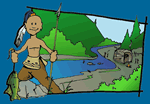


Geography and Landforms:
Montana is bordered by Canada on the north and by Idaho and Wyoming on the south. On the east, Montana is bordered by North and South Dakota, and on the west, it is bordered by Idaho.
|
 History:
The first white explorers to come to Montana were part of the Lewis and Clark expedition in 1804 through 1806. Soon after this group, however, came fur traders and trappers who were interested in the vast natural resources and trade with the Native Americans. Unfortunately, they also brought disease and alcohol to the Native people, and changed their economic system forever. Although the fur trade brought great change to the area, it was relatively short lived, dying out by the 1840s due to the over-hunting of beaver, and the loss of popularity of beaver pelts used for men's hats.
|
 Economy:
Montana's largest industries are agriculture (including both crops and livestock), travel and tourism, timber, and mining. Livestock and wildlife actually outnumber the people in Montana; there are three cows for every person in the state! The state also has the largest grizzly bear population in the US, and the largest elk herd in the US. Other leading agricultural commodities are wheat (ranking fifth in the United States), barley, dairy products, sugar beets, hay, hogs, sheep and lambs. The state is large and sparsely populated, and the economy has always depended upon the area's natural resources. The vast, open plains are perfect for grain farming, and for providing grazing land for large herds of beef cattle.
|
 First Inhabitants:
The first inhabitants of the area now known as Montana were nomadic people who followed the mammoth and the buffalo and gathered plants. Although some tribal people believe their ancestors have lived in the northern Rocky Mountain region since the world began, archaeologists believe the first inhabitants crossed the Bering Strait from Asia around 12,000 years ago. There is evidence of a thriving culture living west of the Rocky Mountains as early as 9,000 years ago.
|
Books Related To MontanaB is for Big Sky Country: A Montana Alphabet - Sneed Collard The Big Burn - Jeanette Ingold Blind Mountain - Jane Resh Thomas Cryer's Cross - Lisa McMann Eye of the Great Bear - Bill Wallace Faithful - Janet Fox Flash Point - Sneed Collard Hattie Big Sky - Kirby Larson Hitch - Jeanette Ingold The Last Exit to Normal - Michael Harmon Mountain Solo - Jeanette Ingold Rescue Josh McGuire - Ben Mikaelsen When the Circus Came to Town - Laurence Yep When the Sargeant Came Marching Home - Don Lemna |
Famous Citizens:
|
| Capital: | Helena |
| Entered Union: | November 8, 1889 |
| Population: | 1,023,579 |
| Area | 147,042 |
| Bird | Western Meadowlark |
| Flower | Bitterroot |
| Nickname: | Treasure State |
| Governor | Steve Bullock |
Places to Visit in Montana: (Click the links to learn more.)
|



